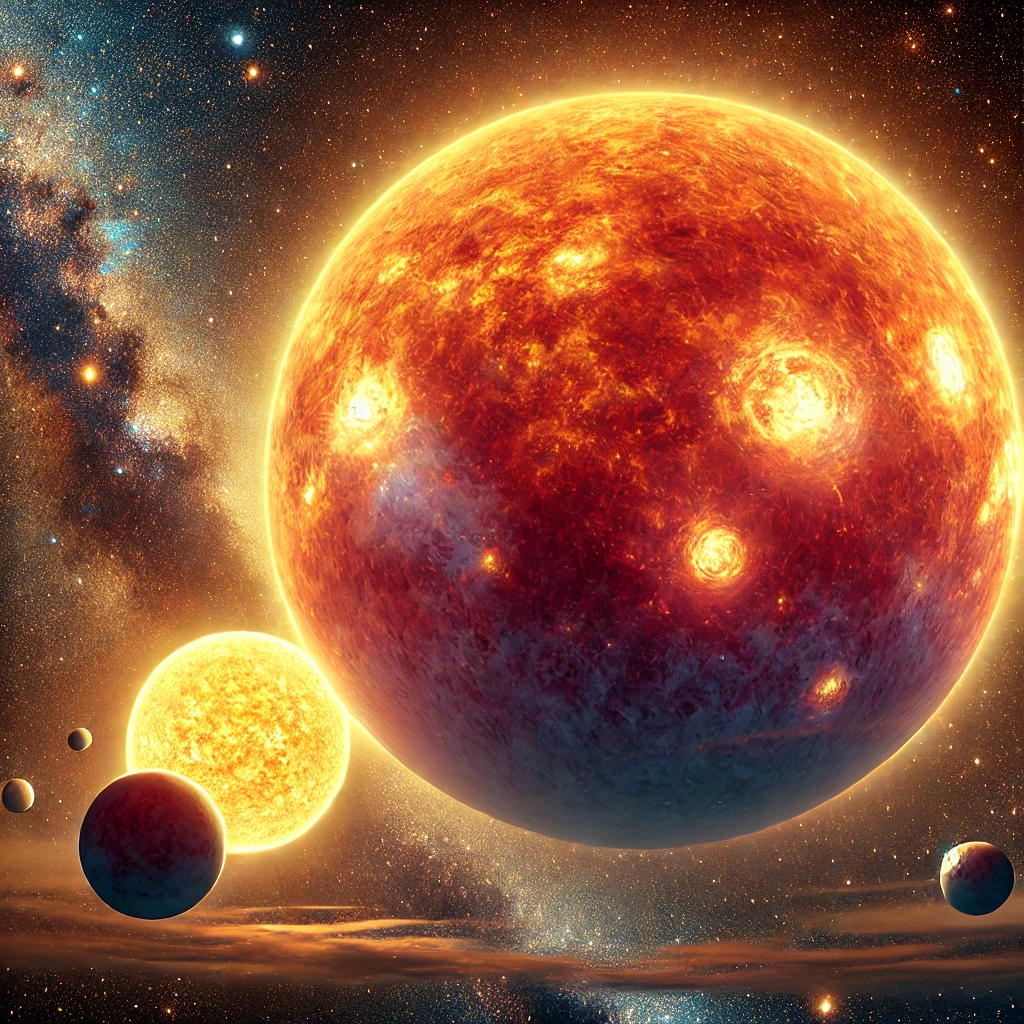Greetings, fellow spacefarers. Captain Nova here, reporting from the cosmic frontier. Today, we embark on a journey to uncover the giants of the universe—the largest and most massive stars ever discovered. These stellar titans burn with unimaginable energy, shaping galaxies, forging elements, and leaving behind some of the most extreme objects in existence.
From red supergiants that could engulf our entire solar system to blue hypergiants that shine millions of times brighter than the Sun, these behemoths defy comprehension.
Let’s take a closer look at these colossal stars and their role in the vast cosmic story.

What Makes a Star “Large”?
When we talk about the largest stars, we can refer to them in two ways:
- Largest by Volume (Radius):
- These stars are the biggest in size, often having huge, bloated atmospheres that stretch across astronomical distances.
- Example: Red supergiants and hypergiants.
- Largest by Mass:
- These stars contain the most amount of matter, meaning they have enormous gravitational forces and burn through their fuel at an accelerated rate.
- Example: Massive blue stars and Wolf-Rayet stars.
Some stars are huge but not extremely massive, while others are supermassive but not particularly large in size. Let’s explore some of the biggest known stars in both categories.
The Biggest Stars by Volume
1. UY Scuti – The Largest Known Star by Radius
- Size: Around 1,700 times the Sun’s radius
- Location: Constellation Scutum, 9,500 light-years away
- Type: Red Supergiant
UY Scuti holds the title of the largest star by volume. If it replaced our Sun, its outer layers would extend beyond Jupiter’s orbit, engulfing most of our solar system. However, despite its enormous size, it isn’t the most massive star.
These red supergiants expand because their outer layers are loosely bound, making them puffy and diffuse rather than incredibly dense.
2. VY Canis Majoris – A True Titan
- Size: Estimated between 1,500–2,000 times the Sun’s radius
- Location: Constellation Canis Major, 3,900 light-years away
- Type: Red Hypergiant
VY Canis Majoris is another contender for the largest star by volume. If placed in our solar system, it could reach Saturn or even farther. This dying star sheds massive amounts of material into space, forming a thick nebula around it. Eventually, it will collapse and explode in a spectacular supernova.
3. Stephenson 2-18 – Possibly the New Record Holder
- Size: Possibly 2,150 times the Sun’s radius
- Location: Open cluster Stephenson 2, 19,500 light-years away
- Type: Red Supergiant
Recent observations suggest Stephenson 2-18 might be even bigger than UY Scuti, possibly making it the largest known star in the universe by volume. However, its exact size is still debated.
These stars may be huge, but their mass is relatively low compared to the most extreme high-mass stars in the universe.
The Most Massive Stars
While red supergiants dominate in size, they don’t always hold the title for most massive. The real monsters of mass are usually blue hypergiants and Wolf-Rayet stars, which can contain hundreds of times the mass of the Sun.
1. R136a1 – The Most Massive Star Ever Found
- Mass: Estimated 200–300 times the Sun’s mass
- Location: Large Magellanic Cloud (Tarantula Nebula), 160,000 light-years away
- Type: Wolf-Rayet Star
R136a1 is the heaviest known star, a hyper-massive blue giant that outshines our Sun millions of times over. These stars are extremely rare because they burn through their fuel incredibly fast and explode in hypernovae—the most powerful supernovae in the universe.
2. Eta Carinae – A Star on the Brink of Explosion
- Mass: Around 150 times the Sun’s mass
- Location: Constellation Carina, 7,500 light-years away
- Type: Luminous Blue Variable (LBV)
Eta Carinae is one of the most unstable stars in the Milky Way. It’s famous for undergoing a massive outburst in the 19th century, temporarily becoming the second brightest star in the night sky.
Astronomers expect Eta Carinae to explode as a supernova within the next few hundred thousand years, possibly leaving behind a black hole.
3. The Pistol Star – A Powerhouse of Light
- Mass: About 100 times the Sun’s mass
- Location: Near the Galactic Center, 25,000 light-years away
- Type: Blue Hypergiant
The Pistol Star produces as much light in 20 seconds as the Sun emits in a year. These types of massive stars generate powerful stellar winds, blowing away their outer layers before they die in a supernova.
The Fate of Massive Stars
These enormous stars live fast and die young. Unlike our Sun, which will burn for about 10 billion years, the largest stars only last a few million years.
When they reach the end of their lives, they undergo catastrophic collapses, leading to different outcomes based on their mass:
- Supernova Explosion – The outer layers are blasted into space, enriching the universe with heavy elements.
- Neutron Star Formation – If the remaining core is between 1.4 and 3 times the Sun’s mass, it collapses into an ultra-dense neutron star.
- Black Hole Formation – If the leftover core is more than 3 times the Sun’s mass, gravity crushes it into a black hole.
These deaths create gamma-ray bursts, pulsars, and even gravitational waves, shaping the cosmos as we know it.
Why Do These Stars Matter?
The largest stars play a key role in the universe:
- They create heavy elements like iron, gold, and oxygen, which form planets and life.
- Their explosions trigger star formation, helping new solar systems form.
- They power galactic evolution, influencing the structure of galaxies with their radiation and winds.
Without these giants, the universe wouldn’t be the same.
Looking Ahead: The Smallest Stars in the Universe
Tomorrow, we shift focus from the giants to the tiniest stars. Some of these small, dim stars burn for trillions of years, potentially outliving the universe itself.
Until then, keep looking up—somewhere out there, these massive stars are lighting up the cosmos.
Captain Nova
Odyssey Explorer
Leave a Reply